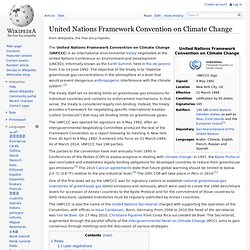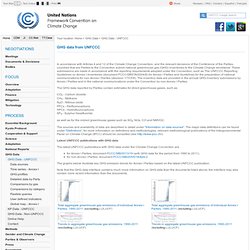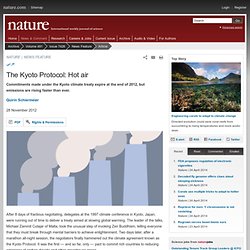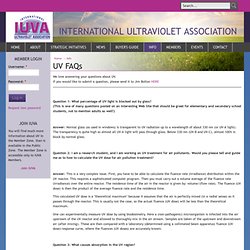

Essential Background. This time line detailing the international response to climate change provides a contextual entry point to the Essential Background.

You can also use the links on the left-hand column under Essential Background to navigate this section. 2013 - Key decisions adopted at COP19/CMP9 include decisions on further advancing the Durban Platform, the Green Climate Fund and Long-Term Finance, the Warsaw Framework for REDD Plus and the Warsaw International Mechanism for Loss and Damage. More on the Warsaw Outcomes. 2012 - The Doha Amendment to the Kyoto Protocol is adopted by the CMP at CMP8.
More on the Doha Amendment. 2011 — The Durban Platform for Enhanced Action drafted and accepted by the COP, at COP17. 2010 — Cancun Agreements drafted and largely accepted by the COP, at COP16. 2009 — Copenhagen Accord drafted at COP15 in Copenhagen. 2007 — IPCC's Fourth Assessment Report released. 2005 — Entry into force of the Kyoto Protocol. 2001 — Release of IPCC's Third Assessment Report. International Energy Statistics. United Nations Framework Convention on Climate Change. The United Nations Framework Convention on Climate Change (UNFCCC) is an international environmental treaty negotiated at the United Nations Conference on Environment and Development (UNCED), informally known as the Earth Summit, held in Rio de Janeiro from 3 to 14 June 1992.

The objective of the treaty is to "stabilize greenhouse gas concentrations in the atmosphere at a level that would prevent dangerous anthropogenic interference with the climate system".[2] The treaty itself set no binding limits on greenhouse gas emissions for individual countries and contains no enforcement mechanisms.
In that sense, the treaty is considered legally non-binding. Instead, the treaty provides a framework for negotiating specific international treaties (called "protocols") that may set binding limits on greenhouse gases. GHG data from UNFCCC. In accordance with Articles 4 and 12 of the Climate Change Convention, and the relevant decisions of the Conference of the Parties, countries that are Parties to the Convention submit national greenhouse gas (GHG) inventories to the Climate Change secretariat.

These submissions are made in accordance with the reporting requirements adopted under the Convention, such as The UNFCCC Reporting Guidelines on Annex I Inventories (document FCCC/SBSTA/2004/8) for Annex I Parties and Guidelines for the preparation of national communications for non-Annex I Parites (decision 17/CP.8). The inventory data are provided in the annual GHG inventory submissions by Annex I Parties and in the national communications under the Convention by non-Annex I Parties. The GHG data reported by Parties contain estimates for direct greenhouse gases, such as: The Kyoto Protocol: Hot air. After 8 days of fractious negotiating, delegates at the 1997 climate conference in Kyoto, Japan, were running out of time to deliver a treaty aimed at slowing global warming.

The leader of the talks, Michael Zammit Cutajar of Malta, took the unusual step of invoking Zen Buddhism, telling everyone that they must break through mental barriers to achieve enlightenment. Two days later, after a marathon all-night session, the negotiators finally hammered out the climate agreement known as the Kyoto Protocol. It was the first — and so far, only — pact to commit rich countries to reducing emissions of carbon dioxide and other greenhouse gases. International Ultraviolet Association. We love answering your questions about UV.If you would like to submit a question, please send it to Jim Bolton HERE Question 1: What percentage of UV light is blocked out by glass?

(This is one of many questions posted on an interesting Web Site that should be great for elementary and secondary school students, not to mention adults as well!) Answer: Normal glass (as used in windows) is transparent to UV radiation up to a wavelength of about 330 nm (or UV-A light). The transparency is quite high so almost all UV-A light will pass through glass.
Below 330 nm (UV-B and UV-C), almost 100% is block by normal glass. Question 2: I am a research student, and I am working on UV treatment for air pollutants. Answer: This is a very complex issue. Testing effectiveness of UV disinfection. UV-C disinfection reduces health risks (Lancet study) - BARO. Ventilation/air conditioning - BARO. 23DAE6C-CIS888614800284458.pdf (application/pdf Object) The Construction Information Service (CIS) supports every stage in the construction lifecycle – from concept and preparation, through design and construction, to operation and ongoing use.

CIS is an expert knowledge tool that delivers key technical information critical to all construction projects in one easy-to-use, web based package. Developed by IHS and the National Building Specification (NBS), it provides instant full-text access to a huge range of key construction related information - current building regulations, construction standards, technical advice and a vast array of related news and briefings.
CIS provides a single point of reference for every construction information need, giving access to a full suite of key construction technical information and insight. CIS is a vital tool for architects, engineers, consultants and anyone involved in the construction and building industry to complete projects accurately, on time , every time.
Science Direct Journals. UV Airstream Disinfection and Airborne Viruses – Ultravation News. Suitability of ultraviolet (A)-light emitting d... [J Med Invest. 2009.